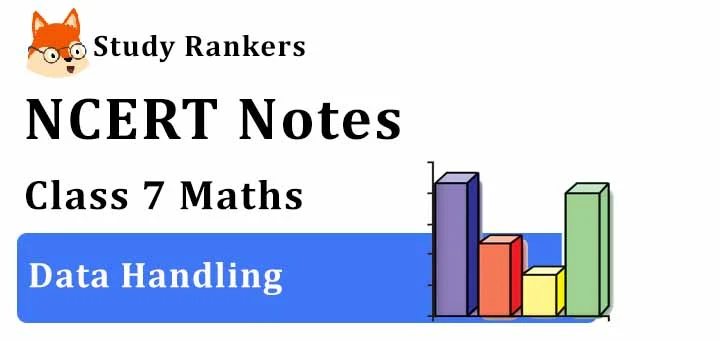Chapter 3 Data Handling Class 7 Notes Maths
Chapter 3 Data Handling Class 7 Notes Maths is given on this page through which student can boost their preparation and assessment of understood concepts. You will easily memorize formulas so you will be very confident about your understanding by now. Also, NCERT Solutions for Class 7 Chapter 3 Maths that will help in completing homework on time. A student will enjoy the revising process and make themselves capable of retaining more information so they can excel in the exams. Class 7 Maths Revision Notes will help you in getting the crux of the chapter.

Data
• Data are the information collected in the form of numbers. Data is organised and represented graphically so that it becomes easy to understand and interpret.
• The collection, recording and presentation of data help us organise our experiences and draw inferences from them.
• Data is organised and represented graphically so that it becomes easy to understand and interpret.
• Consider the data of the ages in years of 10 employees of a office.
40 ,44, 26, 29, 33, 30, 24, 52, 28
Data collected above is called raw data. It is difficult to draw inferences from a raw data.
• 24, 26, 28, 29, 30, 33, 40, 44, 52
Now the data is arranged in ascending order. This arrangement is called an array.
• The difference between the highest and lowest values in a set of data is called its range. Here, range = 52-24 = 28 years.
• The same data can further be arranged in a tabular form using tally marks.
• Bar graph is an visual representation of data. It is formed by using bars of uniform widths.
• Mode of the data is the longest bar, if the bar represents the frequency.
• A double bar graph can be drawn to compare two sets of observations.
Representative Values
• Mean, median and mode are representative values of a group of observations. They are also called measures of central tendency of the data.
Arithmetic mean or mean
• The average or Arithmetic mean or mean of a given data is defined as
Mean = Sum of all observations/Number of observations.
Mode
• The observation that occurs maximum number of times in a data.
• If each of the values in a data is occurring one time or equal number of times, then all are mode.
Median
• Median refers to the value which lies in the middle of the data when arranged in an increasing or
decreasing order with half of the observation above it and other half below it.
• If the data has odd number of items, then the median is the middle number.
• If the data has an even number of items, then the median is the mean of two middle numbers.
• Empirical Formula, 3 Median = Mode + 2 Mean.
Probability
• Chance is a term that describes the likelihood of an event taking place. The situation that may or may not happen, have a chance of happening.
• The probability of an event = Number of favourable outcomes/Total number of outcomes in the experiment.
• The probability of an event which is certain to happen is ‘1’.
• The probability of an event which is impossible to happen is ‘0‘.
